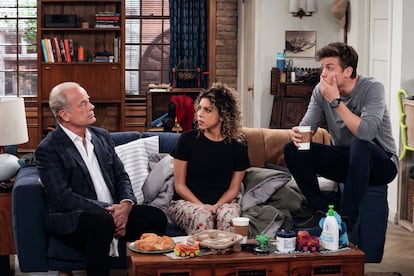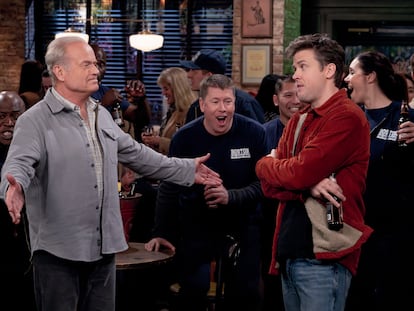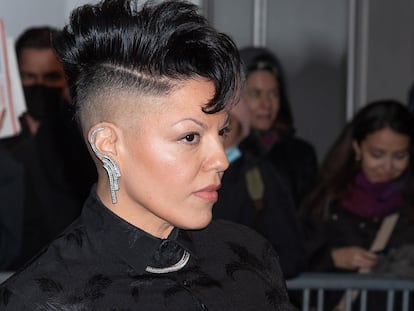‘Frasier’ and comeback comedy sitcoms
Except for the spontaneous laughs, very little of the original survives in the sequel of the great 1990s sitcom — not a disaster, but disappointingly insipid

Today’s television lives on nostalgia, as do many of those who consume it. Reboots, or sequels intended to revive classic series, are the order of the day. In recent years, Sex and the City, Will and Grace, Roseanne and Murphy Brown have spawned modernizations that all have one thing in common: they are all melancholy — and, at times, a bit pathetic — repetitions of their 1990s originals, which are more reminiscent of their characters than their plots. Frasier is the last corpse to emerge from the grave. Kelsey Grammer returns to play the affected and endearing psychiatrist, undoubtedly his greatest role ever — with the exception of Sideshow Bob, to whom he has lent his voice since 1990 on The Simpsons—, even if everything else has changed.
The original series was set in a grunge-free Seattle. The reboot just released by SkyShowtime returns to the place where it all began, Boston, where Frasier’s character first appeared in the 1980s as a member of the large cast of Cheers. It is there that the protagonist is reunited with his son, Freddy, who reproaches him for having been a bad father. To atone for the mistakes of the past, Frasier accepts a job at Harvard, he buys the building where his son lives and forces him to live with him. This seems like a strange solution to prove his love from an expert in the Oedipus complex, as if he had no choice but to share living space with his thirty-something son.
For the sake of modernizing the series, Freddy could have been a young woke man questioning his father’s privilege, his incurable snobbery and his outward apoliticism. The new Frasier is much more conservative. It is a rather lazy conflict between the pompous psychiatrist and his son. Freddy has somewhat shoddy tastes and has dropped out of Harvard to become a firefighter. In a mind-bending leap of continuity, fans of the original series will remember that the last time we saw Freddy he was a gothic teenager with few friends and plenty of allergies. The goal is to recreate Frasier’s conflict with his own father, the magnificent John Mahoney, who passed away in 2018, though the result is a far cry from the original. Niles and Daphne are also absent, and they are undoubtedly missed (Roz and Lilith, Frasier’s frigid ex, will make guest appearances this season).

The original Frasier was packed with outlandish features that made it a unique product of television at the time and defied all the Aristotelian golden rules. It featured playful captions, a bizarre theme song, the absent character of Maris, the dissident masculinity of its protagonists, the oddity of Frasier sleeping with Freud during a wet dream. Except for the spontaneous laughter, very little of the original has survived in this sequel, which is not a disaster, but rather an insipid disappointment. Only Grammer saves the day, with pumped up charm — he even manages to make us forget that he voted for Donald Trump—, even if his over-the-top leading role is in contrast to the hilarity of the first installment’s masterful delivery.
If the young characters are calamitous, the protagonist’s new colleagues at Harvard provide more entertainment: a professor and childhood friend, all of British grace (veteran Nicholas Lyndhurst), and Frasier’s new boss, played by Nigerian Toks Olagundoye, who pushes the series away from the all-white cast that characterized it in the 1990s. In a college party scene, the three star in a hilarious farce reminiscent — to be generous — of those that were so prevalent in the original series, even including jokes in Latin.
This comes in the fifth episode, the last one we have been able to watch, as we begin to discover the vulnerability of these new characters. One of the keys to the success of the first series is the inevitable attachment to its foolishness, paradoxes and traumas. Indeed, the first few episodes of the 1990s Frasier were not so glorious either, though that in no way prevented the 11 seasons that followed from making television history. Perhaps this comeback sitcom needs to be given a little more time. The question is whether the platform will do the same.
Sign up for our weekly newsletter to get more English-language news coverage from EL PAÍS USA Edition
Tu suscripción se está usando en otro dispositivo
¿Quieres añadir otro usuario a tu suscripción?
Si continúas leyendo en este dispositivo, no se podrá leer en el otro.
FlechaTu suscripción se está usando en otro dispositivo y solo puedes acceder a EL PAÍS desde un dispositivo a la vez.
Si quieres compartir tu cuenta, cambia tu suscripción a la modalidad Premium, así podrás añadir otro usuario. Cada uno accederá con su propia cuenta de email, lo que os permitirá personalizar vuestra experiencia en EL PAÍS.
¿Tienes una suscripción de empresa? Accede aquí para contratar más cuentas.
En el caso de no saber quién está usando tu cuenta, te recomendamos cambiar tu contraseña aquí.
Si decides continuar compartiendo tu cuenta, este mensaje se mostrará en tu dispositivo y en el de la otra persona que está usando tu cuenta de forma indefinida, afectando a tu experiencia de lectura. Puedes consultar aquí los términos y condiciones de la suscripción digital.











































